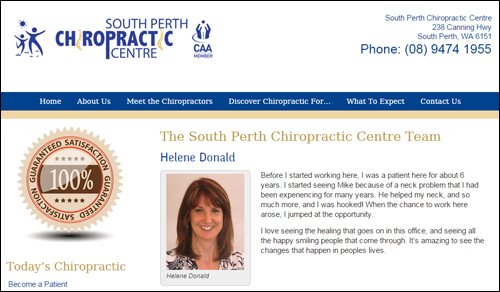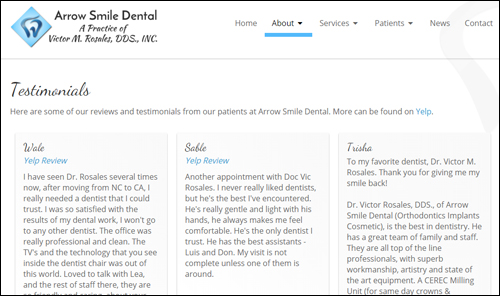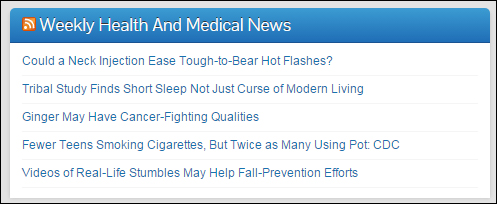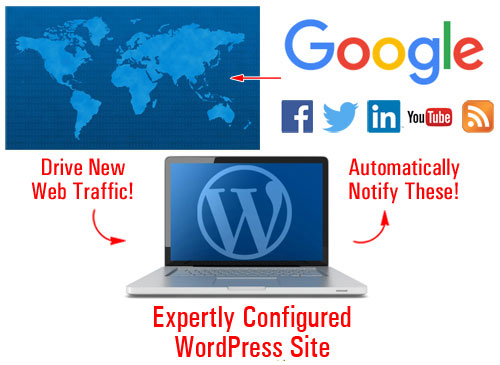Grow Your Medical Or Healthcare Business Online With WordPress


Online Challenges For Medical Professionals
Today, more than ever, medical practitioners must work harder to remain competitive and obtain new clients. Not only do you have to participate in the community you serve, you must also maintain a strong web presence. This includes having an effective web presence and learning how to better promote your services online.
In addition to investing dollars in offline marketing, you will probably find (if you haven’t already) that in order to compete with other medical businesses, you will need to delegate a more significant part of your budget to develop and maintain a website that drives new prospective clients, engages visitors, outperforms the competition in search engines and increases your presence online.
This means that your site not only has to look professional, load fast, and your website has to be easy to navigate, but even more importantly, the needs of your website may change over time and sections will need to be updated often. This requires a well-planned web and content management strategy.
One other problem that health-related businesses (and other businesses) face, is that they have only around thirty seconds to provide visitors with what they are looking for or they will go away.
“Websites have evolved into central information hubs where service information is still present but enhanced with web portals, hyperlinks to state and federal sites, and a variety of free tools.”
Michael Alter, http://www.accountingweb.com/technology/accounting-software/tips-for-improving-your-website
Opportunities For Medical And Health Businesses In The Digital Economy
As well as facing many new challenges, there are also loads of online opportunities available for health practices that can evolve to meet online challenges and can think strategically in terms of improving their online business marketing skills.
In this detailed guide, you will learn a number of ways to attract and engage more visitors and establish stronger online credibility for your business.
![]()
![]()
As well as providing tips and information on ways to improve your business online, we also recommend that you consider using the WordPress platform to power your medical or health business website or blog.
For more information about the benefits and advantages of using the WordPress Content Management System (CMS), see these articles:
- How A Poorly Designed Web Site Can Cost You Customers
- Everything You Need To Know About Growing A Successful Small Business Online With A WordPress Blog
Practical Tips For Improving Your Website
In this section we’ll start with the basics and show you ways to improve your website and get better results online. We will look at what pages a health-related site needs, what type of content works best for health-related websites, your layout and navigation, etc.
If you need assistance or help planning your medical or health-related website, read this detailed guide: The Website Planning Process Explained - A Basic Guide For Business Owners
Ways To Improve Your Web Pages
All websites need a number of essential pages. Let’s take a look at these.
Services And Products Page
It’s essential to have a page that describes your services and any products that you offer. Depending on which area of health or medical services you specialize in, this page can include services like:
- Medicine & Surgery – e.g. ear, nose & throat, orthopedics diabetes, cosmetic surgery, continence management, renal, bariatric surgery, eye diseases operating theaters, etc.
- Dentistry – e.g. preventive dentistry, holistic dentistry, oral health, restorations, implants, emergency dental, etc.
- Cardiology – e.g. cardiac patient rehabilitation, coronary care
- Prenatal and Neonatal – e.g. birth suites, midwifery, etc.
- Child Health – paediatrics, child development, children services, etc.
- Diagnostic – breast screens, skin cancer, x-ray, pap smears, magnetic resonance imaging, food allergy testing, etc.
- Pathology – lab testing and analysis, routine pathology testing, fine-needle aspiration cytology, speech pathology, etc
- Counselling services – mental health services, alcohol, tobacco & other drug services, marriage counselling, diet and nutrition counselling, social work services
- Alternative therapies – acupuncture, reflexology, reiki, tai chi, chiropractic, hypnotherapy, etc.
- Other medical services/therapies – diet and nutrition, podiatry, reproductive services, physiotherapy, medical genetics, prosthetics, hearing aids, home and community care, sexual health, medical equipment, etc.
Make sure to list all of the services you provide, not just the ones you specialize in. Educate your visitors about the benefits of using your services and why they should book an appointment.
About Us
This page needs to describe your business and explain to visitors what it stands for, its unique approach, causes supported, etc.
Remember to also include any medical or health-related awards, recognitions, certifications, accreditations, publications, associations, etc., that could be used to promote your medical, dental, chiropractic, surgery services, etc. and set yourself above your competitors.


(List all of your professional awards certifications, recognitions, accreditations, associations, publications, etc. in your About Us page. Screenshot image source: squaremedical.com.au)
Staff Page
If you are searching for quicker, easier and cheaper ways to sell more products or services online or increase user interaction on your site, then make it easier for visitors to get to know you, your team and your organization better.
You want prospective clients to relate to your business. One great way to do that is to have a page that introduces your team. This page should include a photo and a brief bio. Since most visitors will not tend to be familiar with health or medical-related terms your descriptions should tell who they are and what their specialties are. It should also explain what those specialized areas do. This page can also include social buttons that will allow your prospective clients to follow selected team members on their social networks.
On this page, make sure to highlight your staff member’s expertise and qualifications, how their skills add value or contribute to the success of your team, and more importantly, how they will help add value to your clients’ business.


(Make sure to add a staff page. Image sourced from: southperthchiro.com.au)
To learn more about how to easily add an easy-to-manage simple team directory in your web site without coding skills, see this tutorial: How To Add A Simple Employee List On Your WordPress Site With No Coding Skills
Recruitment
This is a listing of job or career opportunities within the clinic. It could include training offered, employee benefits, opportunities for advancement, etc. You can also include case studies of graduates who have established a solid career path thanks to your organization and information such as the job outlook and new career opportunities in the health-related industry.
Also include a positions available section in your page. If there are no positions currently available, consider inviting people to return periodically to this page, subscribe to your announcements list, follow you on social media, etc.
Testimonials & Case Studies
Reviews from clients and case studies are a great way to attract potential clients and showcase what type of services you offer. Adding a page with case studies and reviews from clients also establishes social proof online.


(Add a page to your site with case studies and reviews from clients. Image sourced from: arrowsmiledental.com)
We have written extensively about using case studies, testimonials and user reviews to grow your business online here: Learn How To Convert More Visitors Into Prospects Using Engaging Testimonials
Contact Us
Having a functional contact page is absolutely necessary.
Your contact page should provide:
- Name Of Your Business
- Physical address
- Phone
- Facsimile number
- Email address
- Google Map and directions
- Website URL
- Contact form
- Request for information – who to contact
- Social media web addresses
- Live chat feature (optional)
If your business services several locations you want to make that clear when showing the address and contact information.
You could also include a few links point to commonly-asked questions page, frequently-visited pages, online booking request, support page, newsletter opt-in form, blog, etc.
Add A Medical Blog
A blog is a powerful business marketing tool. Most blogging platforms typically include a content management system that is simple to use and allows you to easily promote your business by publishing timely content such as events, updates, educational articles and tutorials, opinions and discussions, how-to videos, webinars, etc.
If you already have an health site, then consider adding a WordPress blog to create more exposure for your medical company.
If you don’t have a website yet, or if your existing health-related website is very hard to add new content to or not giving you the results you want, then WordPress can act both as your business website and business blog.
![]()
![]()
Very few businesses know that an expertly configured WordPress site can turn into an automated traffic-generation machine that can begin attracting a stream of targeted visitors to your website, simply by adding regular content to your web site.
(WordPress can automate your traffic generation)
For more info, see this article:
Legal Information
As a professional business, ensuring that you have a website that complies will all legal requirements online is extremely important. This is not only important for establishing credibility with prospective clients, but also to ensure that no laws or regulations are being contravened wherever you do business.
Depending on what services you provide, adding the legal pages below to your health or medical-related site will help you stay out of legal hot water with most regulatory authorities, third-party service providers (e.g. Facebook), and other potential sources of threats and legal inconveniences:
- Contact Us
- Privacy Statement
- Terms Of Use
- Website Disclaimer
- Affiliate Agreement
- Anti-Spam Policy
- Compensation Disclosure
- DMCA Notice
- Earnings Disclaimer
- External Links Policy
- Health and Financial Disclaimers
- Refund Policy
- Video/Audio Terms
- and others
We have written a comprehensive article on adding legal pages to your website. For more details: The Importance Of Adding Legal Pages To Your Site
Tips For Improving Your Web Content
In today’s highly competitive digital economy, the sooner you start publishing good content on your site, the quicker you will begin to see results and differentiate yourself from other competitors.
Providing useful content with information, tips and advice will get your readers to share your web pages and come back for more content. Content marketing is a great way to inform and educate your visitors and prospective clients about using your products and services.
For example, if your business provides products or services that help people manage their weight, then some of the areas you can write content about include:
- What to do before you start any weight loss program (e.g. consult with doctor, record measurements, set goals, etc.)
- How to ask for support when embarking on a weight loss program (friends, family, weight loss seekers)
- Weight loss pills (common ones, side effects, long term results, do they work?)
- Vitamins and minerals that help with weight loss (chromium, calcium, magnesium, etc.)
- And many other content topics
You can also create a series of informative articles that will help your prospective clients gain a better understanding of your services, by explaining benefits, procedures, costs (including payment plans, insurance coverage, etc).
![]()
![]()
Use keywords and terminology in your content that prospective clients will search for.
We recommend subscribing to our Content Marketing Email Training Series. You will receive regular training emails with easy-to-digest information that will teach exactly how to drive more traffic to your web site, save money creating high-quality content for your site visitors and grow your business online using content marketing. It’s not only a great course with loads of useful information, it’s also 100% FREE!
Ways Of Improving Visitor Engagement And User Experience
Improving your site’s user experience (generally referred to as UX) will help you keep visitors coming back and engaging with your site. This section will show you ways you can improve your visitor engagement and UX.
RSS Feeds – Content Syndication
RSS (Really Simple Syndication) feeds can help to improve your visitor engagement and UX in several ways.
If you provide useful content, other businesses may want to syndicate your content.
Some of the benefits of syndicating your content to other businesses using RSS feeds, include:
- All of your updates are in one place
- your content distribution doesn’t rely on email
- RSS feeds can be shared and picked up by other sites online
- Feeds allow users to subscribe
- An RSS feed provides a way for external links to point back to your content
- RSS feeds can be submitted to RSS directories and aggregators
- RSS provides a number of ways for readers to receive your content (e.g. subscribers can view your content on their mobile device using feed readers)
- RSS is built into WordPress
There are also a number of benefits to providing information on your site from other sites, such as the fact that you don’t have to write, manage or update the content.
To find useful RSS feeds for your website, search online for relevant government departments or respected industry bodies.
Below we have listed some examples of feeds you could add to a medical or health-related site:
- US Department Of Health And Human Services – e.g. Latest news feed: http://www.hhs.gov/rss/news/hhsnews.xml, etc. You can also choose specific feeds, like feeds on women’s health issues (e.g. Breastfeeding, Health care for women, Heart health and stroke, Mental health, Pregnancy, etc.) here: http://womenshealth.gov/news/rss/rss-feeds.html
- US National Libraries Of Medicine – For a directory of RSS feeds from leading medical journals, publications and websites (e.g. ACS Publications, American Association of Neurological Surgeons, JCI – The Journal of Clinical Investigation, Current Psychiatry, Cambridge Journals Online, etc.) go here: http://www.healthplusplus.com/wiki/List_of_RSS_feeds_on_health
- National Institutes Of Health - Get many RSS feeds on health-related news and topics here: http://www.nih.gov/Subscriptions.htm
- US Food And Drug Administration (FDA) – Find feeds on fda-related news and topics like consumer health information updates, food safety reports, tainted products, animal and veterinary news, etc. and podcasts here: http://www.fda.gov/AboutFDA/ContactFDA/StayInformed/RSSFeeds
- UK Department Of Health (https://www.gov.uk/government/organisations/department-of-health) – Latest news: https://www.gov.uk/government/organisations/department-of-health.atom
- The Department Of Health (Australian Government): http://www.health.gov.au/internet/main/publishing.nsf/xml/rssLatestNews.xml
- Department Of Public Health (Australia – State Level): e.g. Western Australia – http://www.public.health.wa.gov.au/feed/?types=news
- Centers For Disease Control And Prevention (www.cdc.gov) - Find various health-related news feeds and podcasts here: http://www2c.cdc.gov/podcasts/rss.asp
- Medical News Feeds: You can search medical news feeds in major news publications like the NYTimes RSS feeds section (e.g. Fitness and nutrition: http://www.nytimes.com/services/xml/rss/nyt/Nutrition.xml)
- MedicineNet – MedTerms Medical Word of the Day: http://www.medicinenet.com/rss/dailyword.xml. You can also select individual RSS feeds here (http://www.medicinenet.com/rss/article.htm) (e.g. Alzheimer’s Disease, Arthritis, Cold & Flu, Diabetes, Digestion, Women’s Health, etc.)
- MedicalNewsToday.com – MNT Medical News Headlines: http://rss.medicalnewstoday.com/featurednews.xml
- Medical News Today – You can also choose individual RSS feeds here: http://www.medicalnewstoday.com/newsfeeds-rss (e.g. Gout, Headache/Migraine, Muscular Dystrophy/ALS, Menopause, Endocrinology, Prostate/Prostate Cancer, MRI/PET/Ultrasound, etc.)
You can also search online for general feeds, e.g. “medical rss feeds” or search for feeds on specific areas, e.g. “gerd rss feeds”, “prostate rss feeds”, “oncology rss feeds”, etc.


(Using RSS (Really Simple Syndication) feeds can help to improve your health site’s UX.)
Checklists & Charts
Adding checklists and charts to your site is a great way to help increase visitor engagement and add value to your readers. Checklists and charts can give them useful step-by-step instructions and resources to get necessary tasks done. They are great educational tools.
You can provide a range of checklists and forms covering topics such as:
- Booking appointments
- Checklists for post-surgery recovery
- Health checklists for specific medical conditions
- Dental checklists – e.g. first visit, oral hygiene program, general dentistry, etc.
- Fitness and exercise program checklists and charts
- General charts & infographics (e.g. caloric level of different foods, sleep requirements at different stages of development, etc.)
Adding Online Tools
Providing unique tools and applications on your site can help increase visitor engagement and add value to your visitors. Calculators, for example are useful tools for your website. Other applications can include things like nutritional tools, or even recipes.
In the next section, we will be discussing a several online tools you can use in your website using WordPress plugins that can improve your search engine optimization, increase user engagement and generate more web traffic to your business.


***
This is the end of section 1 of this step-by-step article on ways to improve your health or medical-related business web presence.
Click on this link to read the rest of this guide:
***
***
"This is an awesome training series. I have a pretty good understanding of WordPress already, but this is helping me to move somewhere from intermediate to advanced user!" - Kim Lednum

